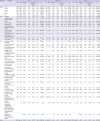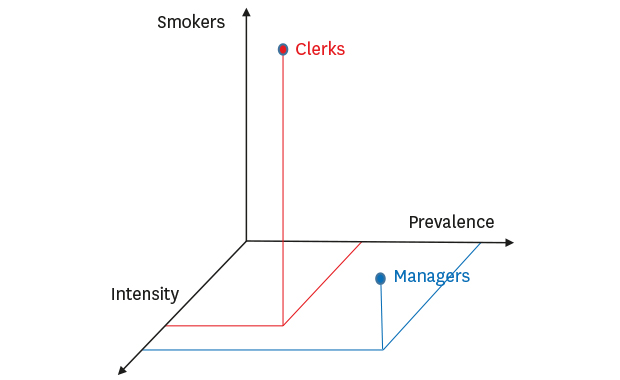1. World Health Organization (WHO). WHO report on the global tobacco epidemic, 2009. Geneva, Switzerland: Research for International Tobacco Control;2010.
2. Miller VP, Ernst C, Collin F. Smoking-attributable medical care costs in the USA. Soc Sci Med. 1999; 48(3):375–391.

3. Ezzati M, Lopez AD. Estimates of global mortality attributable to smoking in 2000. Lancet. 2003; 362(9387):847–852.

4. Danaei G, Vander Hoorn S, Lopez AD, Murray CJ, Ezzati M. Comparative Risk Assessment collaborating group (Cancers). Causes of cancer in the world: comparative risk assessment of nine behavioural and environmental risk factors. Lancet. 2005; 366(9499):1784–1793.

5. Ha BM, Yoon SJ, Lee HY, Ahn HS, Kim CY, Shin YS. Measuring the burden of premature death due to smoking in Korea from 1990 to 1999. Public Health. 2003; 117(5):358–365.

6. Lee H, Yoon SJ, Ahn HS. Measuring the burden of major cancers due to smoking in Korea. Cancer Sci. 2006; 97(6):530–534.

7. Lee SY, Jee SH, Yun JE, Kim SY, Lee J, Samet JM, et al. Medical expenditure of national health insurance attributable to smoking among the Korean population. J Prev Med Public Health. 2007; 40(3):227–232.

8. Erren TC, Jacobsen M, Piekarski C. Synergy between asbestos and smoking on lung cancer risks. Epidemiology. 1999; 10(4):405–411.
9. Meenakshi C, Mohankumar MN. Synergistic effect of radon in blood cells of smokers - an in vitro study. Mutat Res. 2013; 757(1):79–82.

10. Kharchenko TV, Arzhavkina LG, Sinyachkin DA, Yazenok AV, Kryuchkova AS. Smoking as an additional risk factor for the staff of chemically hazardous production facilities. Gig sanit. 2014; (1):77–80.
11. Sandler DP, Wilcox AJ, Everson RB. Cumulative effects of lifetime passive smoking on cancer risk. Lancet. 1985; 1(8424):312–315.

12. Carbone D. Smoking and cancer. Am J Med. 1992; 93(1A):13S–17S.

13. Newcomb PA, Carbone PP. The health consequences of smoking. Cancer. Med Clin North Am. 1992; 76(2):305–331.

14. Ryan J, Zwerling C, Orav EJ. Occupational risks associated with cigarette smoking: a prospective study. Am J Public Health. 1992; 82(1):29–32.

15. Ryan J, Zwerling C, Jones M. Cigarette smoking at hire as a predictor of employment outcome. J Occup Environ Med. 1996; 38(9):928–933.

16. Halpern MT, Shikiar R, Rentz AM, Khan ZM. Impact of smoking status on workplace absenteeism and productivity. Tob Control. 2001; 10(3):233–238.

17. Thompson B, Emmons K, Abrams D, Ockene JK, Feng Z. ETS exposure in the workplace. Perceptions and reactions by employees in 114 work sites. Working well research group [corrected]. J Occup Environ Med. 1995; 37(9):1086–1092.
18. Brownson RC, Hopkins DP, Wakefield MA. Effects of smoking restrictions in the workplace. Annu Rev Public Health. 2002; 23(1):333–348.

19. Kim YS, Rhee KY, Oh MJ, Park J. The validity and reliability of the second Korean working conditions survey. Saf Health Work. 2013; 4(2):111–116.

20. Park J, Lee N. First Korean working conditions survey: a comparison between South Korea and EU countries. Ind Health. 2009; 47(1):50–54.

21. Kim HC, Lamichhane DK, Jung DY, Kim HR, Choi EH, Oh SS, et al. Association of active and passive smoking with occupational injury in manual workers: a cross-sectional study of the 2011 Korean working conditions survey. Ind Health. 2015; 53(5):445–453.

22. Lahelma E, Laaksonen M, Aittomäki A. Occupational class inequalities in health across employment sectors: the contribution of working conditions. Int Arch Occup Environ Health. 2009; 82(2):185–190.

23. Gerlach KK, Shopland DR, Hartman AM, Gibson JT, Pechacek TF. Workplace smoking policies in the United States: results from a national survey of more than 100,000 workers. Tob Control. 1997; 6(3):199–206.

24. Sorensen G, Emmons K, Stoddard AM, Linnan L, Avrunin J. Do social influences contribute to occupational differences in quitting smoking and attitudes toward quitting? Am J Health Promot. 2002; 16(3):135–141.

25. Yzer M, Weisman S, Mejia N, Hennrikus D, Choi K, DeSimone S. Informing tobacco cessation benefit use interventions for unionized blue-collar workers: a mixed-methods reasoned action approach. Prev Sci. 2015; 16(6):811–821.

26. Nho HO, Kim YH, Hong SJ. A study on technostress of information communication technology user. J Korea Converg Soc. 2015; 6(4):41–46.

27. Oho IB, Cho JY. A study on factors affecting job burnout of IT human resources. Korean Public Pers Adm Rev. 2011; 10(2):175–200.
28. Yu SH, Choi HK. Factors influencing on job stress of regional information communication employees. J Digit Converg. 2018; 16(12):351–358.
29. Statistics Korea. Korean Social Trends 2013. Daejeon, Korea: Statistics Korea;2013.
30. Lee KH, Chung WJ, Lee SM. Association of stress level with smoking. J Korean Acad Fam Med. 2006; 27(1):42–48.
31. Kim JJ. Emotional labor in the service industry: status and regulations. Mon Labor Rev. 2013; 102:42–54.
32. Cho HJ, Khang YH, Yun SC. Occupational differentials in cigarette smoking in South Korea: findings from the 2003 social statistics survey. J Prev Med Public Health. 2006; 39(4):365–370.
33. Graham H. Women's smoking and family health. Soc Sci Med. 1987; 25(1):47–56.

34. Kim BG, Pang DD, Park YJ, Lee JI, Kim HR, Myong JP, et al. Heavy smoking rate trends and related factors in Korean occupational groups: analysis of KNHANES 2007–2012 data. BMJ Open. 2015; 5(11):e008229.

35. Kim KW. Call center female worker's labor, smoking and subjectivity [master's thesis]. Seoul: Seoul National University;2013.
36. Bang KM, Kim JH. Prevalence of cigarette smoking by occupation and industry in the United States. Am J Ind Med. 2001; 40(3):233–239.

37. McCurdy SA, Sunyer J, Zock JP, Antó JM, Kogevinas M. European Community Respiratory Health Survey Study Group. Smoking and occupation from the European community respiratory health survey. Occup Environ Med. 2003; 60(9):643–648.

38. Syamlal G, Mazurek JM, Hendricks SA, Jamal A. Cigarette smoking trends among U.S. working adult by industry and occupation: findings from the 2004–2012 national health interview survey. Nicotine Tob Res. 2015; 17(5):599–606.

39. Shavers VL, Lawrence D, Fagan P, Gibson JT. Racial/ethnic variation in cigarette smoking among the civilian US population by occupation and industry, TUS-CPS 1998–1999. Prev Med. 2005; 41(2):597–606.

40. Jang TW, Kim HR, Choi SE, Yim HW, Lee HE, Myong JP, et al. Smoking rate trends in Korean occupational groups: analysis of KNHANES 1998–2009 data. J Occup Health. 2012; 54(6):452–458.

41. Kauppinen T, Toikkanen J, Pedersen D, Young R, Ahrens W, Boffetta P, et al. Occupational exposure to carcinogens in the European Union. Occup Environ Med. 2000; 57(1):10–18.

42. Kauppinen T, Pajarskiene B, Podniece Z, Rjazanov V, Smerhovsky Z, Veidebaum T, et al. Occupational exposure to carcinogens in Estonia, Latvia, Lithuania and the Czech Republic in 1997. Scand J Work Environ Health. 2001; 27(5):343–345.

43. Partanen T, Chaves J, Wesseling C, Chaverri F, Monge P, Ruepert C, et al. Workplace carcinogen and pesticide exposures in Costa Rica. Int J Occup Environ Health. 2003; 9(2):104–111.

44. Peters CE, Ge CB, Hall AL, Davies HW, Demers PA. CAREX Canada: an enhanced model for assessing occupational carcinogen exposure. Occup Environ Med. 2015; 72(1):64–71.

45. Koh DH, Park JH, Lee SG, Kim HC, Choi S, Jung H, et al. Combining lead exposure measurements and experts' judgment through a Bayesian framework. Ann Work Expo Health. 2017; 61(9):1054–1075.

46. Koh DH, Park JH, Lee SG, Kim HC, Choi S, Jung H, et al. Estimation of lead exposure prevalence in Korean population through combining multiple experts' judgment based on objective data sources. Ann Work Expo Health. 2018; 62(2):210–220.

47. Axelson O, Steenland K. Indirect methods of assessing the effects of tobacco use in occupational studies. Am J Ind Med. 1988; 13(1):105–118.

48. Lubin JH, Hauptmann M, Blair A. Indirect adjustment of relative risks of an exposure with multiple categories for an unmeasured confounder. Ann Epidemiol. 2018; 28(11):801–807.

49. Jung-Choi KH, Khang YH, Cho HJ. Hidden female smokers in Asia: a comparison of self-reported with cotinine-verified smoking prevalence rates in representative national data from an Asian population. Tob Control. 2012; 21(6):536–542.










 PDF
PDF Citation
Citation Print
Print




 XML Download
XML Download